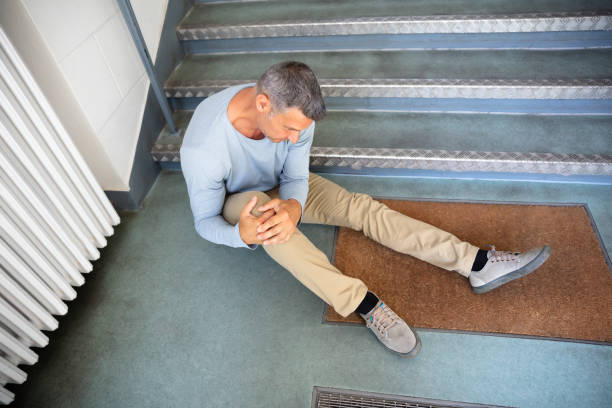Understanding slip and fall accidents is crucial for determining liability in such cases, which can lead to various types of compensation being available, such as financial support for lost wages and medical expenses.
Taking legal steps after an accident, including proper documentation and seeking immediate medical attention, is essential. It’s important to be aware of the time limits and requirements for filing claims, highlighting the significance of seeking legal counsel to navigate the complexities and resolve disputes effectively.
Understanding Slip and Fall Accidents
Slip and fall accidents, often overlooked but potentially severe in consequences, occur when an individual loses balance and falls due to hazardous conditions on a property. Common causes of these accidents include wet or slippery floors, uneven surfaces, poor lighting, loose rugs or mats, and cluttered walkways. To prevent such incidents, property owners can implement various prevention strategies.
Regular maintenance checks to identify and repair any potential hazards promptly is crucial. Additionally, using warning signs in areas where floors may be wet, ensuring proper lighting throughout the property, securing rugs and mats, and keeping walkways clear from obstacles can significantly reduce the risk of slip and fall accidents.
By proactively addressing these common causes and implementing prevention strategies, property owners can create a safer environment for visitors and reduce the likelihood of accidents leading to injuries and potential legal implications.
Determining Liability for Injuries
Determining responsibility for injuries resulting from slip and fall accidents is crucial to legal proceedings following such incidents. Liability determination in these cases often revolves around negligence factors. Establishing liability involves examining whether the property owner or another party failed to uphold their duty of care in maintaining a safe environment. Negligence factors can include wet floors without warning signs, uneven surfaces, poor lighting, or walkway obstacles.
In some slip-and-fall cases, comparative fault may come into play. Comparative fault considers the injured person’s actions in contributing to the accident. If the injured person is found partially responsible for the slip-and-fall, their compensation may be reduced based on the percentage of fault assigned to them. This concept of shared responsibility underscores the importance of assessing all factors that led to the incident to determine the extent of liability on each party involved in the slip-and-fall accident.
Types of Compensation Available
Individuals may be eligible for various types of compensation to address the damages incurred when pursuing legal action after a slip and fall accident. One essential form of compensation is financial support, encompassing lost wages, future earnings that the injury may impact, and other financial losses resulting from the accident. Financial support aims to help individuals recover economically from the consequences of the slip and fall incident.
Moreover, compensation for medical expenses is crucial in covering the costs of healthcare services, rehabilitation, medication, and any other medical needs arising from the injuries sustained in the accident. This type of compensation ensures that individuals can access the necessary medical treatment without financial strain.
Legal Steps to Take After an Accident
After experiencing a slip and fall accident, individuals must promptly take specific legal steps to protect their rights and potential claims. The first crucial step is to ensure proper documentation of the incident. This includes taking photographs of the accident scene, noting any hazardous conditions such as wet floors or uneven surfaces, and obtaining contact information from any witnesses present. It is also essential to seek medical attention immediately to assess and treat any injuries sustained as a result of the fall.
Following these initial steps, individuals should consult a personal injury attorney to understand their legal rights and options. An attorney can guide them through the filing process for a slip-and-fall claim, helping gather necessary evidence to support their case.
Evidence collection may involve obtaining incident reports, medical records, and any other relevant documentation to strengthen the claim. By taking these legal steps after a slip-and-fall accident, individuals can position themselves to seek appropriate compensation for their injuries and damages.

Leave a Reply